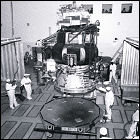 NASA informs the project managers of the Galileo and Magellan interplanetary probes – both of which were due to be launched via space shuttle – that their planned launches are obviously off the schedule due to the destruction of space shuttle Challenger and her crew. Further changes in the shuttle program in the wake of the tragedy will have far-reaching effects, including the cancellation of propulsion modules that would have allowed, for example, Galileo to be put on a direct trajectory toward Jupiter. The Galileo mission plan will undergo significant changes, including the loss of a planned visit to asteroid 29 Amphitrite, and both missions will eventually begin from the cargo bay of space shuttle missions in 1989.
NASA informs the project managers of the Galileo and Magellan interplanetary probes – both of which were due to be launched via space shuttle – that their planned launches are obviously off the schedule due to the destruction of space shuttle Challenger and her crew. Further changes in the shuttle program in the wake of the tragedy will have far-reaching effects, including the cancellation of propulsion modules that would have allowed, for example, Galileo to be put on a direct trajectory toward Jupiter. The Galileo mission plan will undergo significant changes, including the loss of a planned visit to asteroid 29 Amphitrite, and both missions will eventually begin from the cargo bay of space shuttle missions in 1989.

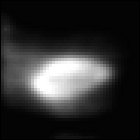 The Soviet Union’s unmanned space probe Vega 1 makes its closest approach to the nucleus of Halley’s Comet, a little over 5,000 miles away (a closer flight path is taken by its twin, Vega 2). Information gathered in the earliest stages of the encounter is shared with the European Space Agency, whose Giotto unmanned probe will make a much closer examination of Halley. Vega 1 registers an immense number of impacts from dust particles, but sustains no serious damage in close proximity to the comet; after several days of observations, Vega 1 is allowed to fall into an orbit around the sun.
The Soviet Union’s unmanned space probe Vega 1 makes its closest approach to the nucleus of Halley’s Comet, a little over 5,000 miles away (a closer flight path is taken by its twin, Vega 2). Information gathered in the earliest stages of the encounter is shared with the European Space Agency, whose Giotto unmanned probe will make a much closer examination of Halley. Vega 1 registers an immense number of impacts from dust particles, but sustains no serious damage in close proximity to the comet; after several days of observations, Vega 1 is allowed to fall into an orbit around the sun. The Soviet Union’s unmanned space probe Vega 2 makes its closest approach to the nucleus of Halley’s Comet, within 5,000 miles of the comet’s icy core. Hundreds of photos are taken and transmitted back to Earth, along with analysis of the dust and gas surrounding the comet. Within a week, Vega 2’s mission is complete, and the probe is allowed to fall into an orbit around the sun as Halley continues to speed back toward the outer solar system.
The Soviet Union’s unmanned space probe Vega 2 makes its closest approach to the nucleus of Halley’s Comet, within 5,000 miles of the comet’s icy core. Hundreds of photos are taken and transmitted back to Earth, along with analysis of the dust and gas surrounding the comet. Within a week, Vega 2’s mission is complete, and the probe is allowed to fall into an orbit around the sun as Halley continues to speed back toward the outer solar system.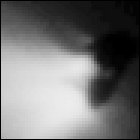 The European Space Agency’s unmanned Giotto space probe makes its closest approach to the nucleus of Halley’s Comet, coming within 400 miles of the comet’s core and taking unprecedented photos that help scientists refine their theories about cometary composition and formation. Giotto pays for the close encounter by taking a beating: its instruments register significant dust impacts, and one impact event jars the spacecraft off of its axis, coming dangerously close to breaking Giotto’s radio contact with Earth and forcing the vehicle to stabilize itself with thrusters. After its encounter with the comet, Giotto falls into a long, looping orbit around Earth, where it will be reactivated to study another comet years later.
The European Space Agency’s unmanned Giotto space probe makes its closest approach to the nucleus of Halley’s Comet, coming within 400 miles of the comet’s core and taking unprecedented photos that help scientists refine their theories about cometary composition and formation. Giotto pays for the close encounter by taking a beating: its instruments register significant dust impacts, and one impact event jars the spacecraft off of its axis, coming dangerously close to breaking Giotto’s radio contact with Earth and forcing the vehicle to stabilize itself with thrusters. After its encounter with the comet, Giotto falls into a long, looping orbit around Earth, where it will be reactivated to study another comet years later.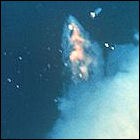 NOAA’s GOES-G Geostationary Operational Environmental Satellite is launched from Cape Canaveral, intended to replace the failed GOES-5 satellite in a geosynchronous orbit over Earth’s western hemisphere. But an electrical fault destroys GOES-G’s Delta booster in flight, and the rocket explodes 71 seconds into its flight. This is NASA’s first attempt to launch a rocket since the Space Shuttle Challenger disaster earlier in 1986, raising new questions about the space agency’s reliability and safety record.
NOAA’s GOES-G Geostationary Operational Environmental Satellite is launched from Cape Canaveral, intended to replace the failed GOES-5 satellite in a geosynchronous orbit over Earth’s western hemisphere. But an electrical fault destroys GOES-G’s Delta booster in flight, and the rocket explodes 71 seconds into its flight. This is NASA’s first attempt to launch a rocket since the Space Shuttle Challenger disaster earlier in 1986, raising new questions about the space agency’s reliability and safety record.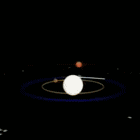 After the cancellation of the Centaur liquid-fueled propulsion module – considered too risky for use aboard the space shuttle, all aspects of which are now under a wide-ranging government review after the Challenger disaster – NASA/JPL’s Galileo Jupiter probe is to begin undergoing modifications for a long, looping trajectory developed by Dr. Roger Diehl and dubbed “VEEGA” – Venus/Earth/Earth Gravity Assist. (Another nickname for this new trajectory, the Solar Cruiser, doesn’t stick in acronym-happy NASA.) VEEGA will see Galileo taking an extra four years to reach Jupiter, getting gravity assists from the planets of the inner solar system during those additional years. Galileo must be modified because it was designed for outer solar system exploration, not exposure to solar heating and radiation within 1 AU of the sun. Since the primary high-gain antenna must be pointed away from Earth during some of this flight, NASA adds a medium-gain antenna to the spacecraft – a last-minute modification which will save the mission when the high-gain antenna fails to open on schedule. Galileo is scheduled for launch via space shuttle in 1989.
After the cancellation of the Centaur liquid-fueled propulsion module – considered too risky for use aboard the space shuttle, all aspects of which are now under a wide-ranging government review after the Challenger disaster – NASA/JPL’s Galileo Jupiter probe is to begin undergoing modifications for a long, looping trajectory developed by Dr. Roger Diehl and dubbed “VEEGA” – Venus/Earth/Earth Gravity Assist. (Another nickname for this new trajectory, the Solar Cruiser, doesn’t stick in acronym-happy NASA.) VEEGA will see Galileo taking an extra four years to reach Jupiter, getting gravity assists from the planets of the inner solar system during those additional years. Galileo must be modified because it was designed for outer solar system exploration, not exposure to solar heating and radiation within 1 AU of the sun. Since the primary high-gain antenna must be pointed away from Earth during some of this flight, NASA adds a medium-gain antenna to the spacecraft – a last-minute modification which will save the mission when the high-gain antenna fails to open on schedule. Galileo is scheduled for launch via space shuttle in 1989. NOAA’s GOES-7 Geostationary Operational Environmental Satellite is launched from Cape Canaveral into a geosynchronous orbit now designated GOES-EAST to monitor weather patterns over the United States. Originally intended for a 1986 launch, GOES-7 has been kept on the ground by the investigation into the destruction just after launch of its predecessor, GOES-G. GOES-7 will become the first of the GOES satellites to operate in both the GOES-EAST and GOES-WEST orbits, and will be retired from active weather-watching duty in 1999, becoming a communications relay satellite until it is decommissioned in 2012.
NOAA’s GOES-7 Geostationary Operational Environmental Satellite is launched from Cape Canaveral into a geosynchronous orbit now designated GOES-EAST to monitor weather patterns over the United States. Originally intended for a 1986 launch, GOES-7 has been kept on the ground by the investigation into the destruction just after launch of its predecessor, GOES-G. GOES-7 will become the first of the GOES satellites to operate in both the GOES-EAST and GOES-WEST orbits, and will be retired from active weather-watching duty in 1999, becoming a communications relay satellite until it is decommissioned in 2012.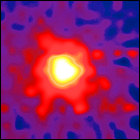 A victory lap after its successful study of Halley’s Comet in 1985 and 1986, the Pioneer Venus Orbiter uses its unique position at the solar system’s second planet to observe another comet, the recently-discovered Comet Wilson. Spotted for the first time only the year before, little is known about Comet Wilson, a lack of data that Pioneer Venus helps to correct by imaging the comet in the ultraviolet portion of the spectrum. Pioneer Venus will also study two other comets later in 1987.
A victory lap after its successful study of Halley’s Comet in 1985 and 1986, the Pioneer Venus Orbiter uses its unique position at the solar system’s second planet to observe another comet, the recently-discovered Comet Wilson. Spotted for the first time only the year before, little is known about Comet Wilson, a lack of data that Pioneer Venus helps to correct by imaging the comet in the ultraviolet portion of the spectrum. Pioneer Venus will also study two other comets later in 1987. NASA has to borrow some of its own spare parts back from the Smithsonian Air & Space Museum to begin engineering mock-up work on the unmanned Venus radar mapping probe Magellan. As JPL works on modifications to a backup central bus component left over from the Voyager program, a physical copy of that bus from an engineering backup of the Voyager spacecraft is loaned back to JPL, shipped to Pasadena from Washington, D.C. (This loan saves JPL the trouble of building another replica of the bus, the central hub of the spacecraft containing its computer and electrical systems, which could add significant cost to the preparations.) The real Magellan, due to be launched soon after the currently grounded space shuttle program resumes, will cut costs by incorporating unused backup equipment from its predecessors, including a Voyager central bus and high-gain antenna, a medium-gain antenna spare from the Mariner missions to Mars, and a Galileo data handling system.
NASA has to borrow some of its own spare parts back from the Smithsonian Air & Space Museum to begin engineering mock-up work on the unmanned Venus radar mapping probe Magellan. As JPL works on modifications to a backup central bus component left over from the Voyager program, a physical copy of that bus from an engineering backup of the Voyager spacecraft is loaned back to JPL, shipped to Pasadena from Washington, D.C. (This loan saves JPL the trouble of building another replica of the bus, the central hub of the spacecraft containing its computer and electrical systems, which could add significant cost to the preparations.) The real Magellan, due to be launched soon after the currently grounded space shuttle program resumes, will cut costs by incorporating unused backup equipment from its predecessors, including a Voyager central bus and high-gain antenna, a medium-gain antenna spare from the Mariner missions to Mars, and a Galileo data handling system.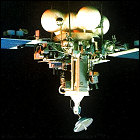 The Soviet Union launches the first of two unmanned Phobos space probes, designed to investigate the largest of Mars’ two asteroid-like moons and deliver a lander to analyze that moon’s surface. With multiple nations pitching in resources to help the mission succeed, including the United States, the Phobos program is intended to be the definitive Mars exploration program of the 1980s, as well as the debut of a new Soviet interplanetary vehicle to take over from the Zond/Venera design in use since the 1960s.
The Soviet Union launches the first of two unmanned Phobos space probes, designed to investigate the largest of Mars’ two asteroid-like moons and deliver a lander to analyze that moon’s surface. With multiple nations pitching in resources to help the mission succeed, including the United States, the Phobos program is intended to be the definitive Mars exploration program of the 1980s, as well as the debut of a new Soviet interplanetary vehicle to take over from the Zond/Venera design in use since the 1960s.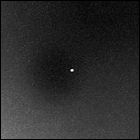 From within 500 million miles, cameras aboard NASA’s Voyager 2 unmanned space probe can now get a better look at planet Neptune than is possible with ground-based telescopes on Earth – even though, at present, that means a tiny disk only eight pixels across in images measuring 800 x 800 pixels. Voyager 2 is still over a year away from its closest encounter with Neptune, and even its own best photos don’t reveal any detail in the blue-green planet’s atmosphere. What is known is that, despite receiving less than half the sunlight and heat of the next innermost planet, Uranus, Neptune maintains the same temperature as Uranus. This means that Neptune is generating more heat than it receives from the sun.
From within 500 million miles, cameras aboard NASA’s Voyager 2 unmanned space probe can now get a better look at planet Neptune than is possible with ground-based telescopes on Earth – even though, at present, that means a tiny disk only eight pixels across in images measuring 800 x 800 pixels. Voyager 2 is still over a year away from its closest encounter with Neptune, and even its own best photos don’t reveal any detail in the blue-green planet’s atmosphere. What is known is that, despite receiving less than half the sunlight and heat of the next innermost planet, Uranus, Neptune maintains the same temperature as Uranus. This means that Neptune is generating more heat than it receives from the sun.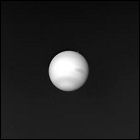 For the first time, images transmitted to Earth by NASA’s unmanned Voyager 2 space probe reveal visible cloud features in the atmosphere of Neptune, from a distance of 185,000,000 miles. This is a welcome relief to mission scientists who felt let down by a lamentable lack of any atmospheric detail in the clouds of Uranus, a planet visited by Voyager 2 in 1986. In the months ahead, even more detail will be revealed in Neptune’s upper atmosphere.
For the first time, images transmitted to Earth by NASA’s unmanned Voyager 2 space probe reveal visible cloud features in the atmosphere of Neptune, from a distance of 185,000,000 miles. This is a welcome relief to mission scientists who felt let down by a lamentable lack of any atmospheric detail in the clouds of Uranus, a planet visited by Voyager 2 in 1986. In the months ahead, even more detail will be revealed in Neptune’s upper atmosphere.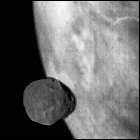 The Soviet Union’s unmanned Mars probe Phobos 2 successfully arrives in orbit around the red planet after over half a year of interplanetary travel (and after the loss of its identical twin, Phobos 1). Phobos 2 begins taking pictures of both Mars and Phobos and begins a series of orbital maneuvers that will eventually lead it to a very close approach to Phobos, where it is expected to release a pair of surface landers, the first of their kind to study a Martian moon.
The Soviet Union’s unmanned Mars probe Phobos 2 successfully arrives in orbit around the red planet after over half a year of interplanetary travel (and after the loss of its identical twin, Phobos 1). Phobos 2 begins taking pictures of both Mars and Phobos and begins a series of orbital maneuvers that will eventually lead it to a very close approach to Phobos, where it is expected to release a pair of surface landers, the first of their kind to study a Martian moon. The Soviet Union loses all contact with the unmanned Mars probe Phobos 2 during a close flyby of the inner Martian moon Phobos, where the vehicle had been programmed to deposit a pair of surface landers. Unable to reacquire communications with Phobos 2, Soviet ground controllers later discover a fatal error in the programming of the probe’s on-board computer, leading to a loss of attitude control similar to the incident that doomed Phobos 1 in 1988. Since delivery of the landers never occurs, the mission is deemed a failure.
The Soviet Union loses all contact with the unmanned Mars probe Phobos 2 during a close flyby of the inner Martian moon Phobos, where the vehicle had been programmed to deposit a pair of surface landers. Unable to reacquire communications with Phobos 2, Soviet ground controllers later discover a fatal error in the programming of the probe’s on-board computer, leading to a loss of attitude control similar to the incident that doomed Phobos 1 in 1988. Since delivery of the landers never occurs, the mission is deemed a failure. Images transmitted to Earth by NASA’s unmanned Voyager 2 spacecraft, from a distance of 129,000,000 miles, reveal a consistent feature in Neptune’s atmosphere, an oval-shaped storm system near the Neptunian equator very similar in size and position to the Great Red Spot on Jupiter. This storm, quickly nicknamed the Great Dark Spot, allows Voyager scientists to estimate Neptune’s rotational period much earlier than expected. At the distance between Voyager 2 and Neptune, the smallest features on the planet that can be seen are at least 2,400 miles across, meaning the newly detected storm system is gigantic.
Images transmitted to Earth by NASA’s unmanned Voyager 2 spacecraft, from a distance of 129,000,000 miles, reveal a consistent feature in Neptune’s atmosphere, an oval-shaped storm system near the Neptunian equator very similar in size and position to the Great Red Spot on Jupiter. This storm, quickly nicknamed the Great Dark Spot, allows Voyager scientists to estimate Neptune’s rotational period much earlier than expected. At the distance between Voyager 2 and Neptune, the smallest features on the planet that can be seen are at least 2,400 miles across, meaning the newly detected storm system is gigantic. Space Shuttle Atlantis lifts off on a four-day mission to launch the long-delayed interplanetary probe Magellan, which is sent to Venus via an Interial Upper Stage booster module. For the first time, one of a shuttle’s five onboard computers fails and is replaced in an in-orbit repair procedure. Aboard Atlantis for this flight are Commander David Walker, Pilot Ronald Grabe, and mission specialists Norm Thagard, Mary Cleave and Mark Lee. The launch of Magellan, a mission originally conceived in 1972, marks the beginning of the first American interplanetary mission since 1977.
Space Shuttle Atlantis lifts off on a four-day mission to launch the long-delayed interplanetary probe Magellan, which is sent to Venus via an Interial Upper Stage booster module. For the first time, one of a shuttle’s five onboard computers fails and is replaced in an in-orbit repair procedure. Aboard Atlantis for this flight are Commander David Walker, Pilot Ronald Grabe, and mission specialists Norm Thagard, Mary Cleave and Mark Lee. The launch of Magellan, a mission originally conceived in 1972, marks the beginning of the first American interplanetary mission since 1977.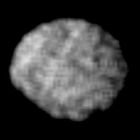
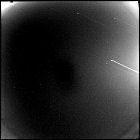 NASA announces the confirmation of what are believed to be partial rings around planet Neptune, as discovered in images taken by the unmanned Voyager 2 space probe. The ring arcs are found in close proximity to several new satellites, also spotted in Voyager 2 images, which are too small to have been seen form Earth-based telescopes. Ground-based telescopes had led scientists to believe that they would find partial rings, or complete dark rings, at Neptune; at this time, however, and at a distance of 13 million miles, what the project scientists don’t expect is that the rings will be revealed to completely encircle the planet within mere weeks.
NASA announces the confirmation of what are believed to be partial rings around planet Neptune, as discovered in images taken by the unmanned Voyager 2 space probe. The ring arcs are found in close proximity to several new satellites, also spotted in Voyager 2 images, which are too small to have been seen form Earth-based telescopes. Ground-based telescopes had led scientists to believe that they would find partial rings, or complete dark rings, at Neptune; at this time, however, and at a distance of 13 million miles, what the project scientists don’t expect is that the rings will be revealed to completely encircle the planet within mere weeks.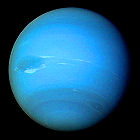 The unmanned space probe Voyager 2, almost exactly 12 years after leaving Earth, visits its last planet in the solar system, Neptune. Since mission planners have no further targets for Voyager, they have a free hand in picking its final destinations. An extremely close trajectory over Neptune’s north pole, bringing Voyager 2 within 18,000 miles of the cloudtops of the solar system’s windiest planet, deflects Voyager downward behind Neptune for a close look at its large moon, Triton. Six new moons are discovered, and the “ring arcs” that astronomers have theorized for years turn out to be complete rings made of extremely dark material. After the surprisingly featureless face of Uranus, Neptune proves to be unexpectedly active, with a large dark storm dominating its atmosphere.
The unmanned space probe Voyager 2, almost exactly 12 years after leaving Earth, visits its last planet in the solar system, Neptune. Since mission planners have no further targets for Voyager, they have a free hand in picking its final destinations. An extremely close trajectory over Neptune’s north pole, bringing Voyager 2 within 18,000 miles of the cloudtops of the solar system’s windiest planet, deflects Voyager downward behind Neptune for a close look at its large moon, Triton. Six new moons are discovered, and the “ring arcs” that astronomers have theorized for years turn out to be complete rings made of extremely dark material. After the surprisingly featureless face of Uranus, Neptune proves to be unexpectedly active, with a large dark storm dominating its atmosphere.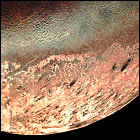 As scientists marvel over the latest data and pictures from Voyager 2 as it leaves Neptune, images of the planet’s large moon Triton prove to be jaw-dropping. Active geysers blast dark material – possibly evidence of cryovolcanism – over the moon’s mottled surface, and an atmosphere is measured. Virtually no craters caused by meteor impacts are spotted, meaning that Triton’s surface is geologically active – all completely new discoveries to Earth-based scientists. Perhaps the most frustrating part of all of the new information is that no further missions to Neptune are in serious consideration by NASA to follow up on Voyager 2’s discoveries.
As scientists marvel over the latest data and pictures from Voyager 2 as it leaves Neptune, images of the planet’s large moon Triton prove to be jaw-dropping. Active geysers blast dark material – possibly evidence of cryovolcanism – over the moon’s mottled surface, and an atmosphere is measured. Virtually no craters caused by meteor impacts are spotted, meaning that Triton’s surface is geologically active – all completely new discoveries to Earth-based scientists. Perhaps the most frustrating part of all of the new information is that no further missions to Neptune are in serious consideration by NASA to follow up on Voyager 2’s discoveries. NASA’s unmanned Voyager 2 space probe leaves the vicinity of the planet Neptune, the outermost planet to have been explored by a man-made spacecraft. (At this point in time, Pluto is still considered a planet – the only one to which NASA hasn’t sent a space probe – though by the time a vehicle is dispatched to Pluto in the 21st century, Pluto has been demoted to “minor planet” status.) Though not expected to function beyond 2025 due to the slow decay of its nuclear power source, Voyager 2 may survive long enough to pass within 25,000,000,000,000 miles of Sirius in a quarter of a million years.
NASA’s unmanned Voyager 2 space probe leaves the vicinity of the planet Neptune, the outermost planet to have been explored by a man-made spacecraft. (At this point in time, Pluto is still considered a planet – the only one to which NASA hasn’t sent a space probe – though by the time a vehicle is dispatched to Pluto in the 21st century, Pluto has been demoted to “minor planet” status.) Though not expected to function beyond 2025 due to the slow decay of its nuclear power source, Voyager 2 may survive long enough to pass within 25,000,000,000,000 miles of Sirius in a quarter of a million years. NASA releases
NASA releases 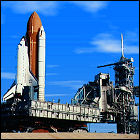 A lawsuit, filed by environmental activists worried about the release of plutonium from the Galileo Jupiter probe’s radioisotope thermoelectric generators in the event of a Challenger-like disaster during launch, is dismissed by a federal judge; the President of the United States has also given permission for the launch to proceed (a requirement anytime a nuclear-fueled spacecraft is in the works). The suit, filed earlier in the year, sought an injunction to prevent Galileo from being launched. Times have changed since the last RTG-powered flight (the Voyager missions of the 1970s), and activists are concerned about a Chernobyl-style radioactive disaster, although the plutonium 238 at the heart of Galileo’s power supply (and that of other interplanetary probes that have used it) is non-weapons-grade and non-fissible. Galileo is slated to be launched in a week aboard the space shuttle Atlantis.
A lawsuit, filed by environmental activists worried about the release of plutonium from the Galileo Jupiter probe’s radioisotope thermoelectric generators in the event of a Challenger-like disaster during launch, is dismissed by a federal judge; the President of the United States has also given permission for the launch to proceed (a requirement anytime a nuclear-fueled spacecraft is in the works). The suit, filed earlier in the year, sought an injunction to prevent Galileo from being launched. Times have changed since the last RTG-powered flight (the Voyager missions of the 1970s), and activists are concerned about a Chernobyl-style radioactive disaster, although the plutonium 238 at the heart of Galileo’s power supply (and that of other interplanetary probes that have used it) is non-weapons-grade and non-fissible. Galileo is slated to be launched in a week aboard the space shuttle Atlantis. Space Shuttle Atlantis lifts off on a mission lasting nearly five days, whose primary goal is to lift the interplanetary probe Galileo into orbit. Originally intended for launch in late 1982, Galileo is bound for Jupiter by way of a
Space Shuttle Atlantis lifts off on a mission lasting nearly five days, whose primary goal is to lift the interplanetary probe Galileo into orbit. Originally intended for launch in late 1982, Galileo is bound for Jupiter by way of a 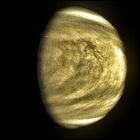 NASA/JPL’s Galileo space probe – eventually bound for Jupiter – reaches the first destination on its looping “
NASA/JPL’s Galileo space probe – eventually bound for Jupiter – reaches the first destination on its looping “ At the request of astronomer Carl Sagan, NASA and JPL reawaken Voyager 1‘s camera for a last look back at Earth and its solar system, from a mind-boggling distance of 4,000,000,000 miles. The “last look” is actually composed of 60 separate photos, capturing most of the planets (with the exception of Mars and Mercury), including Earth – which takes up less than a single pixel in the image. Sagan points to the image as evidence of the fragility and uniqueness of Earth, and names his next book after the photo, “Pale Blue Dot”, also centered on that theme.
At the request of astronomer Carl Sagan, NASA and JPL reawaken Voyager 1‘s camera for a last look back at Earth and its solar system, from a mind-boggling distance of 4,000,000,000 miles. The “last look” is actually composed of 60 separate photos, capturing most of the planets (with the exception of Mars and Mercury), including Earth – which takes up less than a single pixel in the image. Sagan points to the image as evidence of the fragility and uniqueness of Earth, and names his next book after the photo, “Pale Blue Dot”, also centered on that theme. 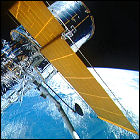 In the planning stages since the 1970s, and delayed by the post-Challenger-disaster downtime for the shuttle program, the Hubble Space Telescope is finally lifted into orbit aboard Space Shuttle Discovery. Hubble is just one of the scientific payloads for the five-day flight, with other experiments being conducted in the crew cabin and the cargo bay. Discovery’s crew for this flight is Commander Loren Shriver, Pilot Charles Bolden, and mission specialists Steven Hawley, Bruce McCandless and Kathryn Sullivan.
In the planning stages since the 1970s, and delayed by the post-Challenger-disaster downtime for the shuttle program, the Hubble Space Telescope is finally lifted into orbit aboard Space Shuttle Discovery. Hubble is just one of the scientific payloads for the five-day flight, with other experiments being conducted in the crew cabin and the cargo bay. Discovery’s crew for this flight is Commander Loren Shriver, Pilot Charles Bolden, and mission specialists Steven Hawley, Bruce McCandless and Kathryn Sullivan. The earliest test images from the Hubble Space Telescope alert ground-based astronomers to a serious problem: the telescope’s huge mirror has been ground to an incorrect shape, leaving the $2,000,000,000 telescope with a vision problem resulting in blurry pictures. Though they’re still an improvement over ground-based telescopes, the telescope’s main selling point – high-resolution images of distant objects – is moot. With the public considering the expensive satellite a failure (oblivious to the fact that it can be serviced via Space Shuttle), NASA begins an extensive investigation into the problem, arriving at a possible repair that can’t be applied until the first shuttle servicing mission to Hubble in 1993. In the meantime, attempts to correct the problem with Earthbound computer image processing yield some usable images.
The earliest test images from the Hubble Space Telescope alert ground-based astronomers to a serious problem: the telescope’s huge mirror has been ground to an incorrect shape, leaving the $2,000,000,000 telescope with a vision problem resulting in blurry pictures. Though they’re still an improvement over ground-based telescopes, the telescope’s main selling point – high-resolution images of distant objects – is moot. With the public considering the expensive satellite a failure (oblivious to the fact that it can be serviced via Space Shuttle), NASA begins an extensive investigation into the problem, arriving at a possible repair that can’t be applied until the first shuttle servicing mission to Hubble in 1993. In the meantime, attempts to correct the problem with Earthbound computer image processing yield some usable images.